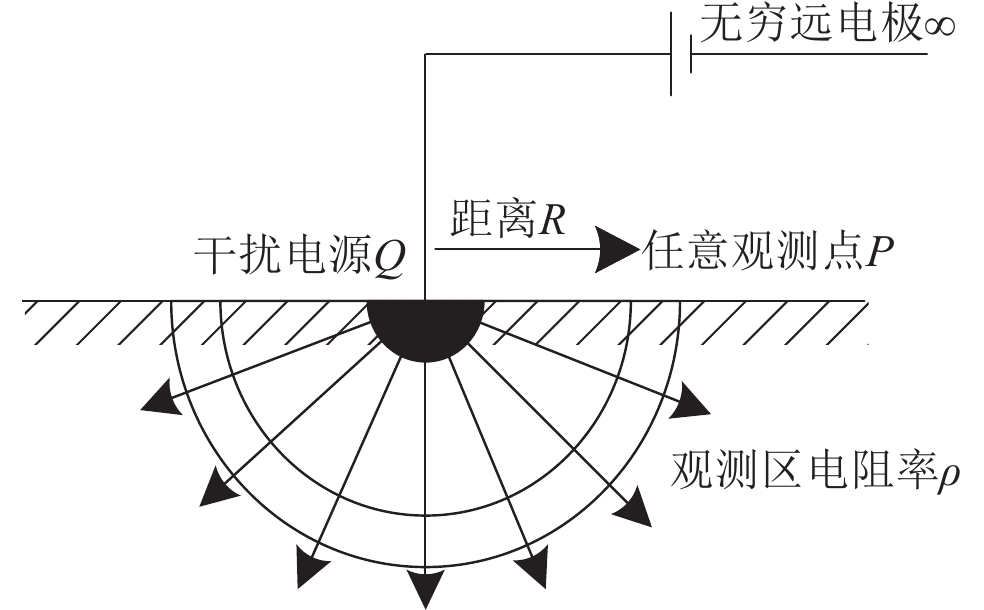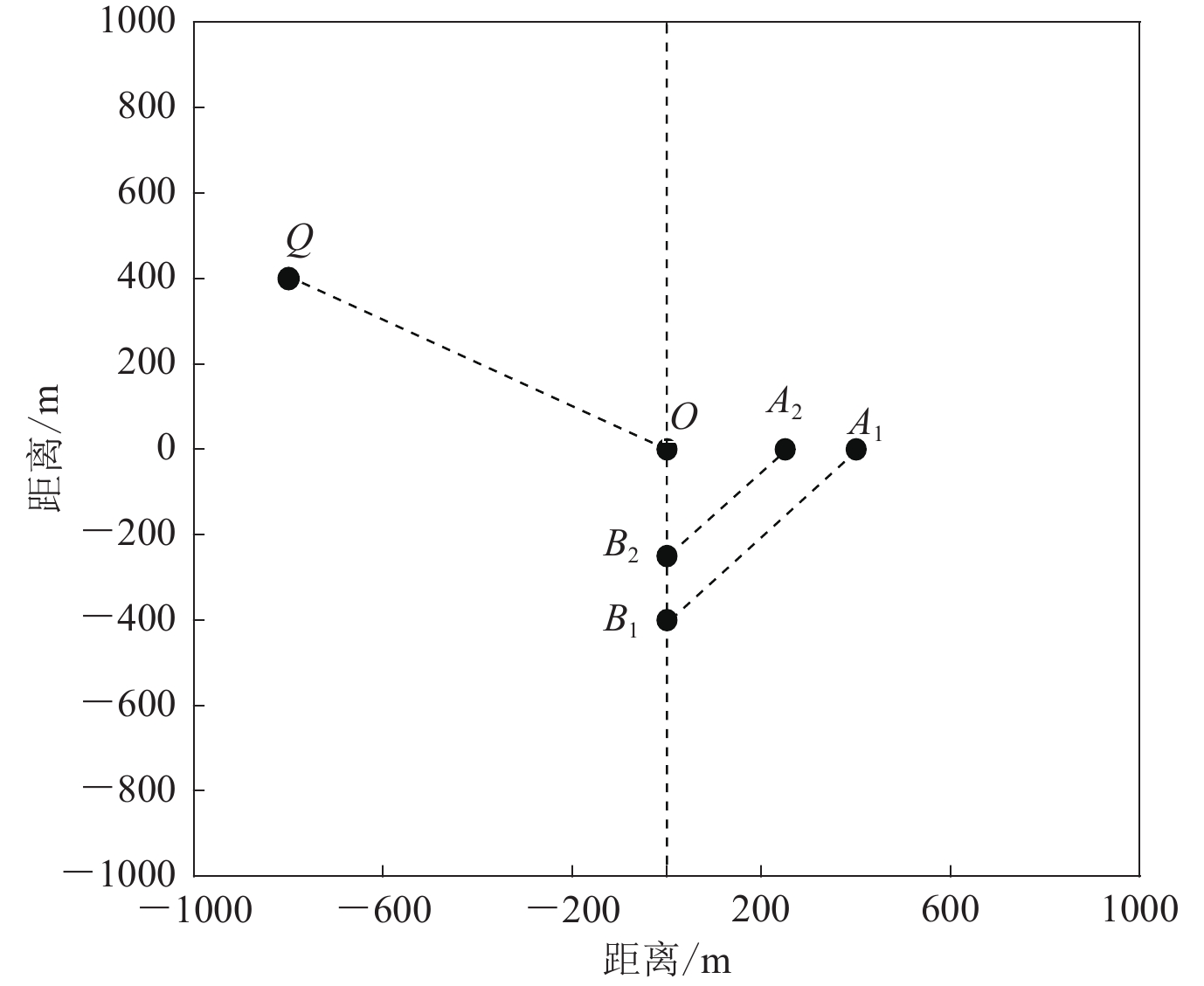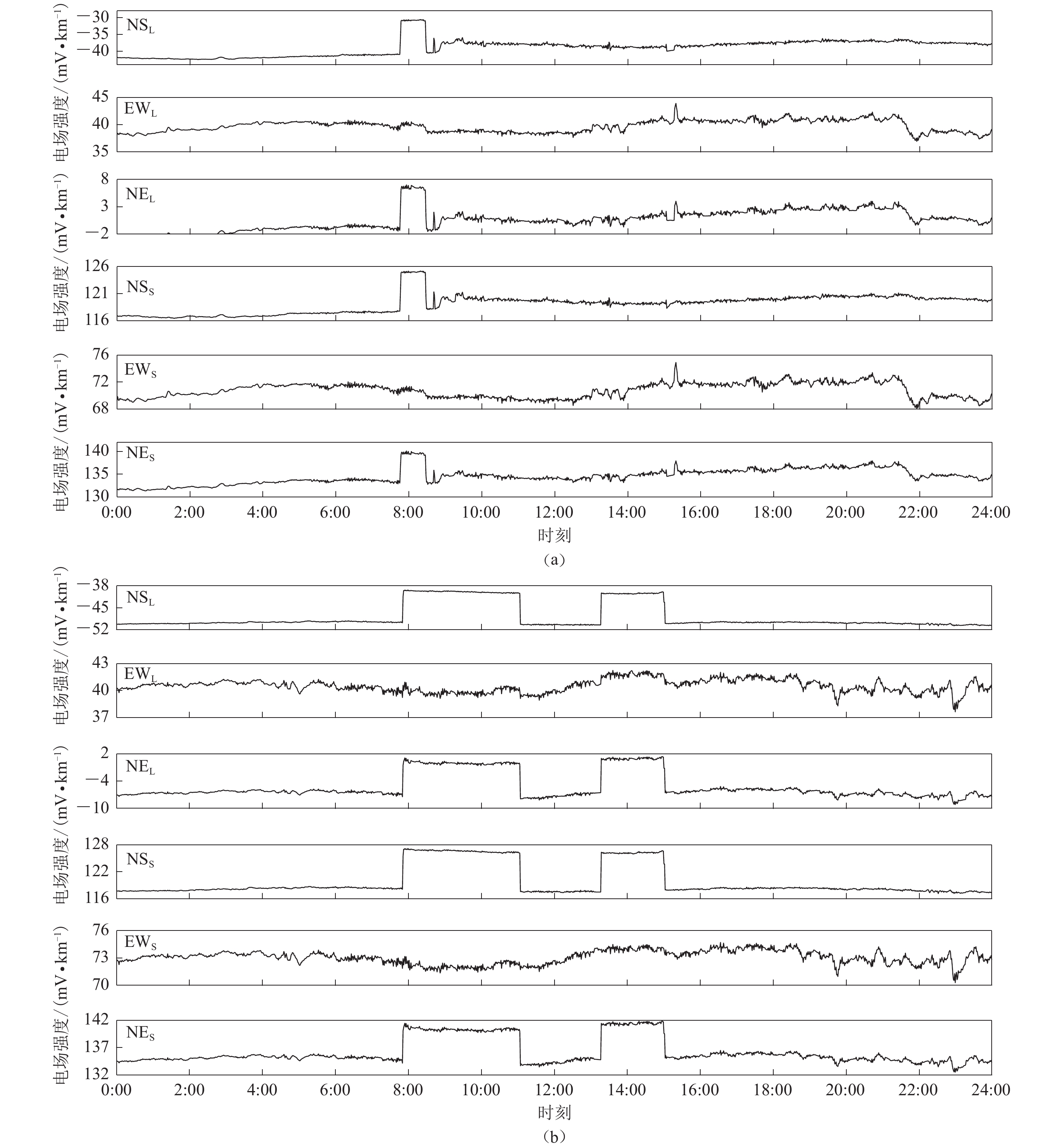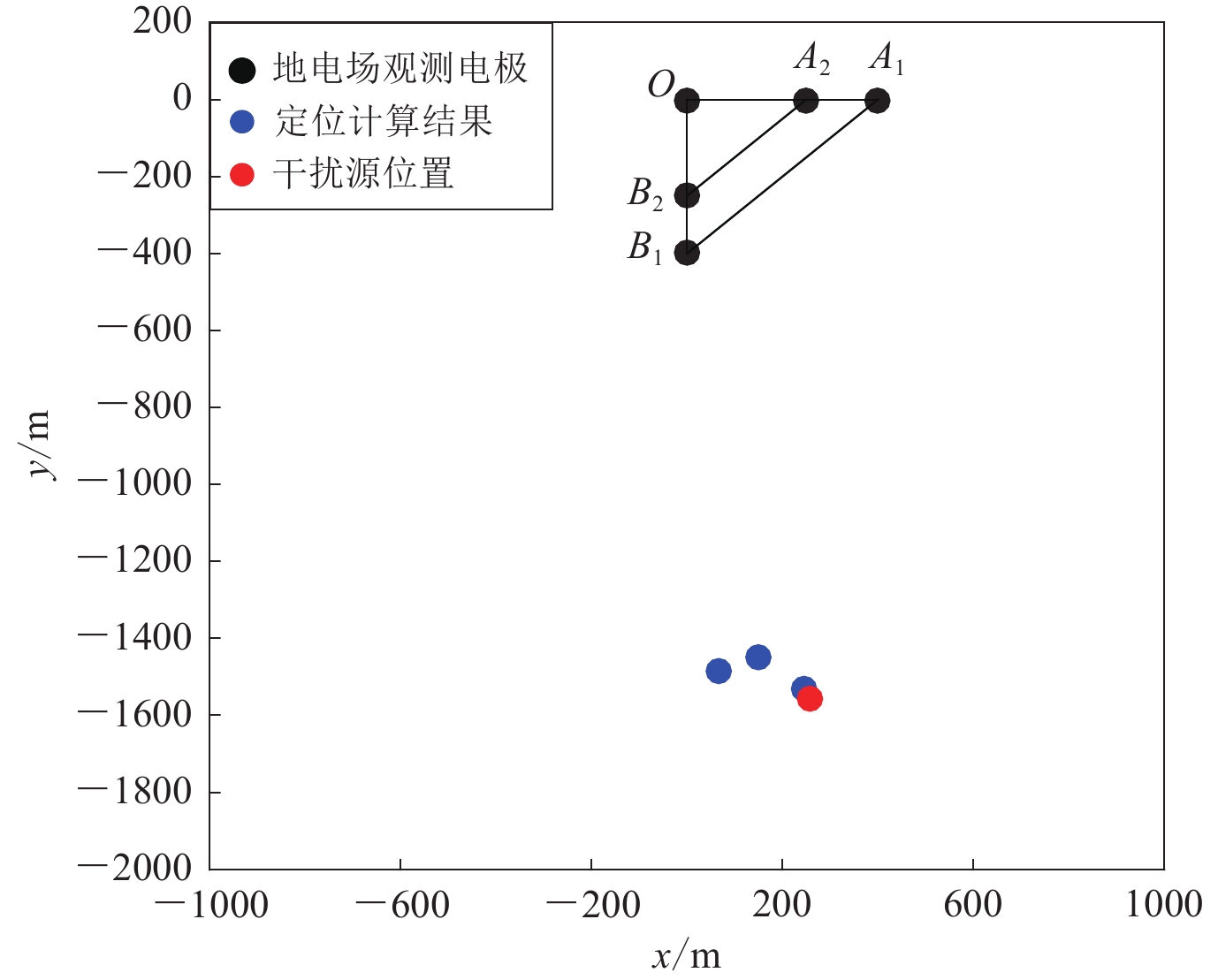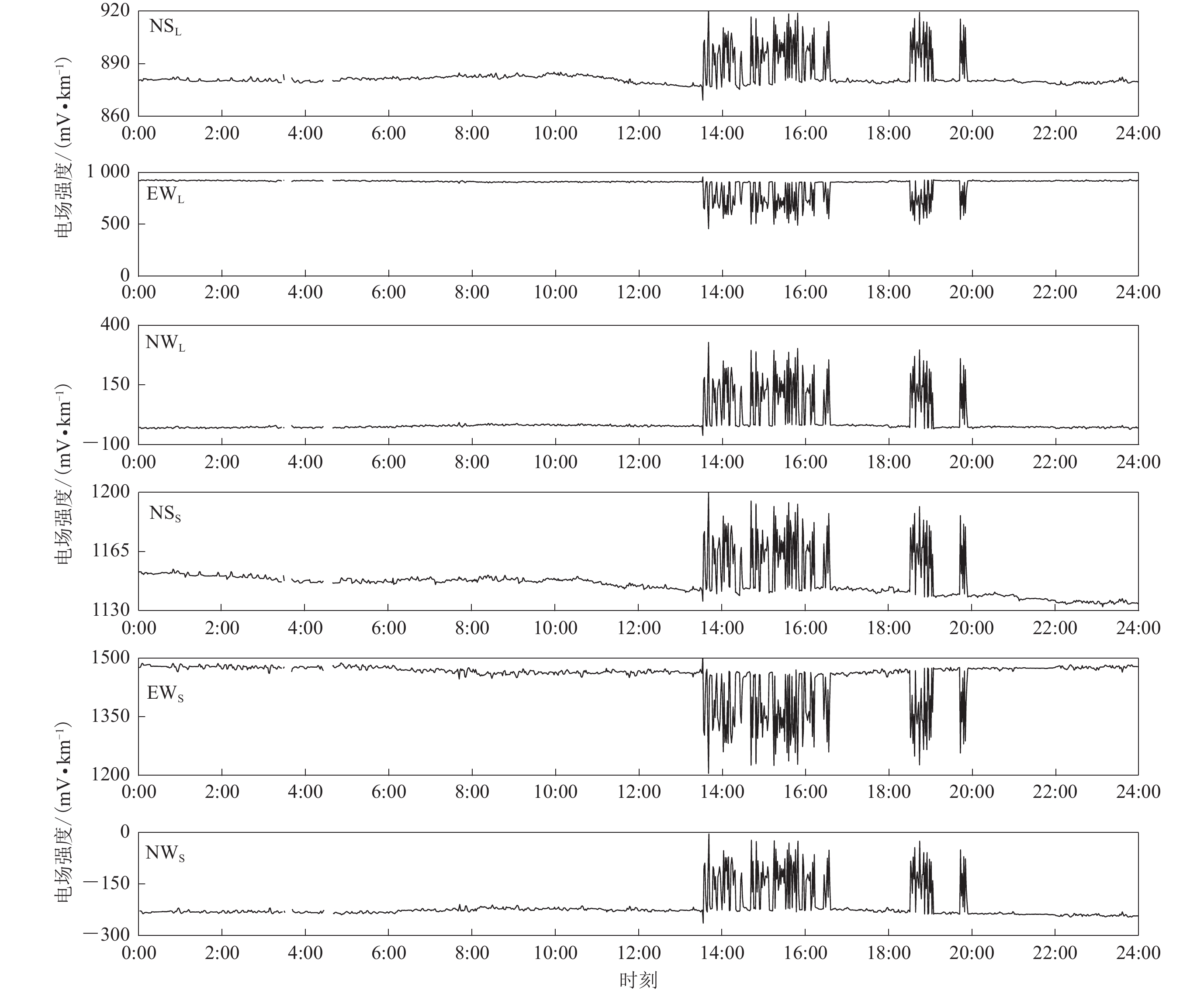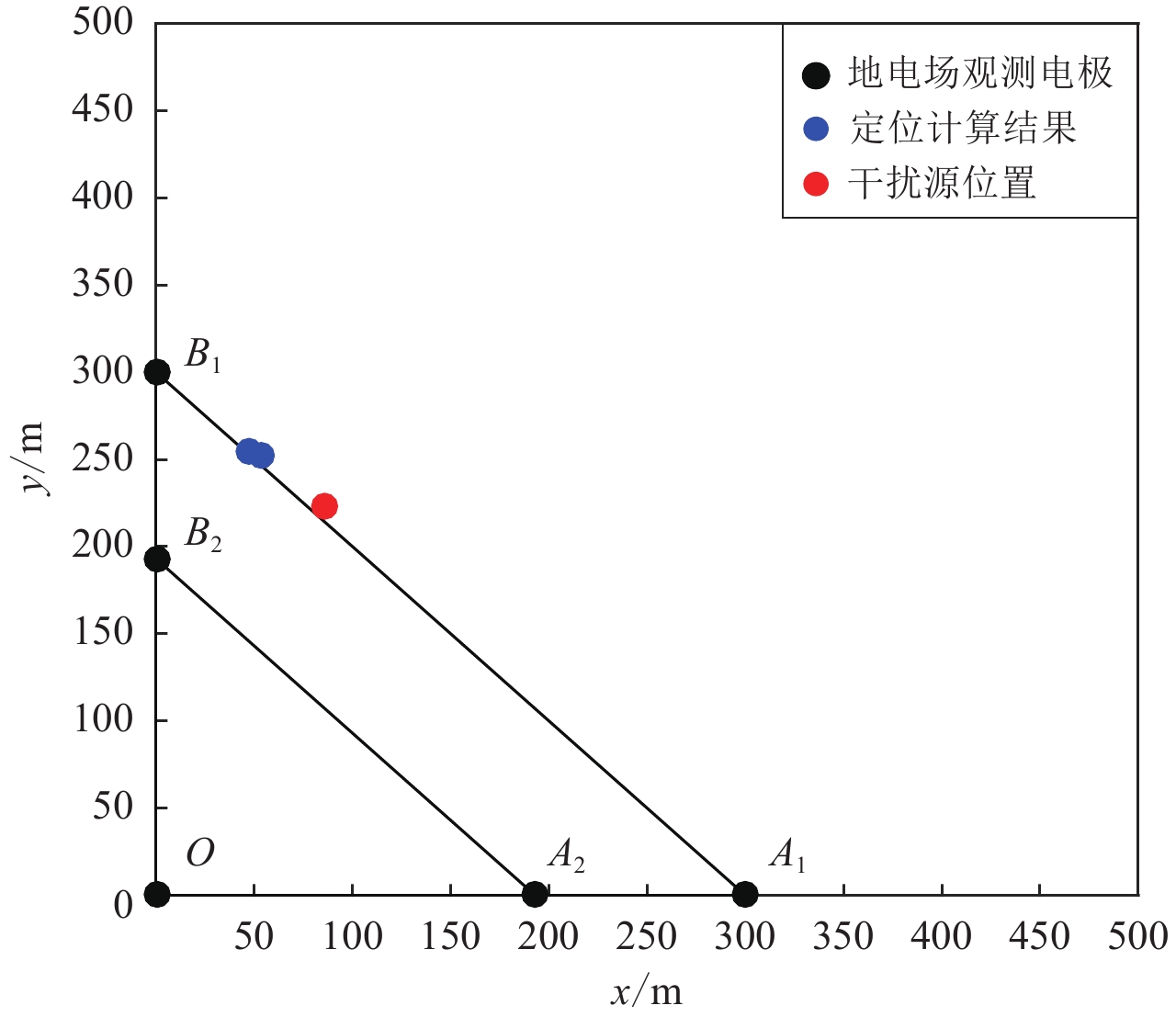Location method of point interference source and its practical application in geoelectric field observation
-
摘要:
我国地震地电场观测时的漏电干扰问题会影响到观测质量和地震监测效能。针对这一实际问题,本文提出了点源干扰源定位方法。该方法首先建立地表点源对地电场观测影响模型,根据模型计算点源对地电场观测的干扰幅度,然后求解干扰源相对于中心电极的位置。将定位方法应用于高邮地震台和汉王地震台实际干扰源排查工作中,定位结果与实际干扰源位置基本一致,测区外干扰源定位误差小于2%,测区内干扰源定位误差小于20 m,并对影响计算误差的因素进行了分析。两个台站的实际应用表明:本文提出的定位方法为地电观测实践中查找点源漏电干扰源提供解决方案,能够有效地定位点源干扰源位置,提高干扰排查效率。
Abstract:China’s seismic network currently comprises 113 geoelectric field monitoring stations. To effectively utilize geoelectric field monitoring data for earthquake prediction, it is crucial to accurately differentiate between seismic and non-seismic anomalies. However, with the rapid development of China’s economy, agricultural production, and industrial construction around these monitoring stations, interference from electrical equipment leakage has escalated. This interference represents a significant non-seismic anomaly that adversely affects the quality of observation data and its application efficiency. 1) The impact of electrical equipment leakage on geoelectric field observation can be characterized as follows: 2) The observation curve exhibits significant steps, peaks, or dips. 3) The daily variation pattern of the geoelectric field is suppressed. 4) The amplitude of each component of the geoelectric field varies due to the relative positions of the leakage points. 5) The interference in each channel begins and ends at the same time, synchronized with the leakage period, although the degree of influence may differ. 6) The interference amplitude is inversely proportional to the distance between the interference source and the electrode and directly proportional to the magnitude of the leakage current. Leakage interference within the measurement area constitutes a non-seismic anomaly that significantly impacts the quality of the observation data. Therefore, it is essential to identify and promptly investigate sources of interference in daily earthquake monitoring to minimize data loss caused by such interference. Currently, two types of interference sources can be identified based on examples encountered by stations: point source interference and dipole source interference. However, there is currently no high-precision positioning algorithm available for point sources. This study established a point source interference model based on a uniform semi-infinite space, analyzed the theoretical influence amplitude of point sources on geoelectric field observation through model theory, proposed a point source interference localization method, and applied the algorithm to the actual interference investigation work of Gaoyou Station in Jiangsu Province and Hanwang Station in Gansu Province. The position of the interference source was calculated based on the observed interference shape and change amplitude. The positioning direction and area were consistent with the actual interference source position. The positioning error of interference sources outside the measurement area was less than 2%, and the positioning error of interference sources inside the measurement area was less than 20 meters. The main sources of positioning calculation errors are as follows: First, this method establishes a point source model based on a uniform semi-infinite medium, but the underground medium of the station is not completely uniform and isotropic. The non-uniform structure of the underground electrical properties will affect the propagation of electric field signals, resulting in certain calculation errors. However, this error has a relatively small effect, and the source of interference can still be located in a small area. Second, when the observation data is interfered with, the interference signal and the ground electric field observation signal are superimposed, and the ground electric field is constantly changing, making it difficult to accurately extract the interference amplitude. Inaccurate extraction of the interference amplitude leads to errors in the calculation results. In subsequent applications, multiple positioning calculations can be used to calculate the average and minimize the error in the calculation results. The positioning algorithm proposed in this article provides a sound solution for identifying point source leakage interference.
-
引言
我国处于地震活动多发区域,在地震孕育发生过程中,地壳介质应力会发生变化,地壳介质的电性也会随之改变,引起地电场的异常变化(Varotsos et al,1981;Varotsos,Alexopoulos,1984;毛桐恩等,1999;黄清华,2005;钱复业,赵玉林,2005)。在文安MS5.1地震、汶川MS8.0地震、玉树MS7.1地震、芦山MS7.0地震、岷县漳县MS6.6地震等多次中强以上地震前,均记录到了比较明显的地电场异常变化(马钦忠,2008;谭大诚等,2012;田山等,2012;安张辉等,2013,2015;范莹莹等,2013,2015;席继楼等,2016,2018)。
我国地震地电台网现有113个地电场观测台站,地电场观测数据在地震预测中有效应用的前提是能够正确识别地震异常和非震异常。随着我国社会经济的飞速发展,地震地电观测台站周边农业生产和工业建设增多,不可避免地会出现用电设备漏电对地电观测的干扰影响,测区漏电干扰就是一种严重影响观测数据质量的非震异常。这种干扰通常影响幅度非常大,严重影响观测数据质量和应用效能(林向东等,2007;马君钊等,2010;陈志刚等,2012;卫清等,2017;张宇等,2017;赵玉红等,2019)。测区用电设备漏电产生的干扰电场将叠加到原有地电场上,从而增大或减小地电场测值(龚永俭等,2020),地电场观测受漏电影响的特征一般表现为:① 观测曲线出现大幅度阶跃、抬升或降低;② 受干扰严重测道,地电场日变化形态受到压制;③ 由于漏电点相对被测电场的位置不同,造成地电场各分量变幅不同;④ 虽然不同测道影响程度不同,但各测道受干扰开始时间和结束时间相同,与漏电时段同步性较强;⑤ 干扰幅度与干扰源与电极距离成反比,与漏电流大小成正比。
测区漏电干扰是一种严重影响观测数据质量的非震异常,需要在日常地震监测工作中识别并尽快排查干扰源,减小受干扰而造成数据不可用的损失。通常根据台站遇到的用电设备漏电干扰实例,可将干扰源分为点源和偶极源干扰,且干扰源一般分布在地表测区内或测区附近1—2 km。陈志刚等(2012)、应允翔等(2018)和赵玉红等(2019)利用干扰幅度的矢量合成初步定位干扰源的方位和范围,但该方法只能判断大致漏电位置的排查方向,不能准确定位。张宇等(2017)对偶极干扰源干扰模型和定位方法进行了研究,并通过模拟干扰源的试验对该方法进行了验证,认为其能够实现快速定位,将干扰源圈定在小区域范围内(卫清等,2017;张宇等,2017)。但是台站实际观测中遇到的干扰源大多为近似点源干扰,王福才等(2013)建立了点源干扰源模型计算干扰源位置,但是该模型计算结果与实际情况误差较大,模型与实际情况存在较大差异,定位效果不理想。
对于点源干扰源,目前还没有精度较高的定位算法。本文针对这个问题开展研究,建立基于均匀半无限空间的点源干扰源模型,得到任一点受点源干扰电位计算公式,将实际受干扰电场变化幅度与理论计算结果进行比较,可求解出干扰源位置。该方法对于测区内干扰源和测区外干扰源均具有比较好的定位效果,定位误差较小。
1. 点源干扰源定位求解算法
1.1 地电场观测布极方式
地震地电场观测到的物理量为天然地电场,是大地电场和自然电场的综合反映。地电场观测方法是在地表选定方向后,按一定间距埋设电极,测量电极点之间的电位差。在测区电场均匀的条件下,电极间电位差与电极距离之比为选定方向的电场强度值。
地震台站地电场观测时,通常采用如图1所示的四种“L”型布极方式(全国地震标准化技术委员会,2009)。其中,中心公共电极(O1和O2)布设于同一位置,以下均按照O来讨论,其它四个电极A1,A2,B1,B2与公共电极O构成三个地电场观测方向,分别为南北测向(B1O和B2O两组)、东西测向(A1O和A2O两组)和斜向(A1B1和A2B2两组),每组又分为长极距观测和短极距观测。
设五个电极的电位分别为$U_{ O}$,$U_{ {A_1}}$,$U_{ {A_2}}$,$U_{ {B_1}}$和$U_{ {B_2}}$,根据电场定义可以得到6组电场值,即
$$ \left\{\begin{array}{l}{E}_{1}=\dfrac{{V}_{B_1O}}{B_1O}=\dfrac{{U}_{B_1}-{U}_{O}}{B_1O} \text{,} \\ {E}_{2}=\dfrac{{V}_{OA_1}}{A_1O}=\dfrac{{U}_{O}-{U}_{A_1}}{A_1O} \text{,} \\ {E}_{3}=\dfrac{{V}_{B_1A_1}}{B_1A_1}=\dfrac{{U}_{B_1}-{U}_{A_1}}{B_1A_1} \text{,} \\ {E}_{4}=\dfrac{{V}_{B_2O}}{B_2O}=\dfrac{{U}_{B_2}-{U}_{O}}{B_2O} \text{,} \\ {E}_{5}=\dfrac{{V}_{OA_2}}{A_2O}=\dfrac{{U}_{O}-{U}_{A_2}}{A_2O} \text{,} \\ {E}_{6}=\dfrac{{V}_{B_2A_2}}{B_2A_2}=\dfrac{{U}_{B_2}-{U}_{A_2}}{B_2A_2} \text{,} \end{array}\right. $$ (1) 式中,分子为两电极之间电位差,分母为两电极之间距离,E1和E4分别为南北方向长、短极距电场,E2和E5分别为东西方向长、短极距电场,E3和E6分别为斜向长、短极距电场。
1.2 点源干扰源模型及定位算法
当漏电位置位于地表时,可将该干扰源视为地表点电流源,设地面为无限大平面,地下充满均匀且各向同性的导电介质,该点源会在一定范围内形成一个稳定电场(李金铭,2005),本研究亦基于均匀半无限介质建立点源干扰源模型。点源形成的人工场与原有天然地电场叠加,地电场观测系统将观测到受干扰影响的电场值。
当点电流源Q自地表向地下供入电流I时,地中电流线的分布便以Q为中心向周围呈辐射状(图2)。
设地电场观测中地表任意一个观测电极为P,P到干扰点源Q的距离为R。则干扰源Q对P点产生的电位为
$$ \tilde{U}=\frac{\rho \tilde{I}}{2\pi }\frac{1}{R} \text{,} $$ (2) 式中:$ \tilde{I} $为漏电电流,实际漏电流多为不稳定电流,因此漏电流为变量;ρ为观测区域的电阻率值;R为电极到干扰点源的距离。设$C= \dfrac{\rho \tilde{I}}{2\pi }$,C是随电流变化的量值,则
$$ \tilde{U}=\frac{C}{R} {\text{.}} $$ (3) 在实际地电场观测中,设点源干扰源与地电场观测的各电极位置关系如图3所示,则布极区的5个测点都会受到干扰点源Q形成的电流场的影响,且干扰电场叠加在原有地电场中。
根据式(3)可以计算得到某时刻干扰源Q在每个测量点产生的电位差,分别用${{U} \text{′}_ O},{U}\text{′}_{ A_1}$,${U}\text{′}_{ A_2}$,${U}\text{′}_{ B_1}$和${U}\text{′}_{ B_2}$表示,带入式(1)可得到受干扰影响后的电场,即
$$ \begin{split} \\ \left\{\begin{array}{l} {E}\text{′}_{ 1} = {E}_{1}+\dfrac{{U}\text{′}_{ B_1}-{U}\text{′}_{ O}}{B_1O} = {E}_{1}+C\left(\dfrac{1}{{R}_{B_1}}-\dfrac{1}{{R}_{O}}\right) \Bigg/ B_1O \text{,} \\ {E}\text{′}_{ 2} = {E}_{2}+\dfrac{{{U}\text{′}_{ O}-U}\text{′}_{ A_1}}{A_1O} = {E}_{2}+C\left(\dfrac{1}{{R}_{O}}-\dfrac{1}{{R}_{A_1}}\right) \Bigg/ A_1O \text{,} \\ {E}\text{′}_{ 3} = {E}_{3}+\dfrac{{{U}\text{′}_{ B_1}-U}\text{′}_{ A_1}}{B_1A_1} = {E}_{3}+C\left(\dfrac{1}{{R}_{B_1}}-\dfrac{1}{{R}_{A_1}}\right) \Bigg/ B_1A_1 \text{,} \\ {E}\text{′}_{ 4} = {E}_{4}+\dfrac{{U}\text{′}_{ B_2}-{U}\text{′}_{ O}}{B_2O} = {E}_{4}+C\left(\dfrac{1}{{R}_{B_2}}-\dfrac{1}{{R}_{O}}\right) \Bigg/ B_2O \text{,} \\ {E}\text{′}_{ 5} = {E}_{5}+\dfrac{{U}\text{′}_{ A_2}-{U}\text{′}_{ O}}{A_2O} = {E}_{5}+C\left(\dfrac{1}{{R}_{O}}-\dfrac{1}{{R}_{A_2}}\right) \Bigg/ A_2O \text{,} \\ {E}\text{′}_{ 6} = {E}_{6}+\dfrac{{{U}\text{′}_{ B_2}-U}\text{′}_{ A_2}}{B_2A_2} = {E}_{6}+C\left(\dfrac{1}{{R}_{B_2}}-\dfrac{1}{{R}_{A_2}}\right) \Bigg/ B_2A_2\text{,} \end{array}\right. \end{split} $$ (4) 式中,$ {E}_{i} $为正常观测地电场,${E}\text{′}_{i}$为受干扰影响后的地电场,两斜向电场值$ {E}_{3} $和$ {E}_{6} $可由正交测向电场值矢量合成得到。与干扰源电流场平行方向受到的干扰最大,与干扰源电流场垂直方向受到的干扰最小。无论干扰源在什么位置,三个观测方向总有两个方向能够观测到干扰影响造成的地电场观测数据突变,在实际应用中选择受干扰影响较大的两个方向的地电场变化值建立方程组,则式(4)可简化为4个方程,分三种情况(式(5)—式(7)),即
$$\left\{\begin{array}{l} ( {E}\text{′}_{ 1}-{E}_{1} ) {\text{×}} B_1O=C{\text{×}} \left(\dfrac{1}{{R}_{B_1}}-\dfrac{1}{{R}_{O}}\right) \text{,} \\ ( {E}\text{′}_{ 2}-{E}_{2} ) {\text{×}} A_1O=C{\text{×}} \left(\dfrac{1}{{R}_{O}}-\dfrac{1}{{R}_{A_1}}\right) \text{,} \\ ( {E}\text{′}_{ 4}-{E}_{4} ) {\text{×}} B_2O=C{\text{×}} \left(\dfrac{1}{{R}_{B_2}}-\dfrac{1}{{R}_{O}}\right) \text{,} \\ ( {E}\text{′}_{ 5}-{E}_{5} ) {\text{×}} A_2O=C{\text{×}} \left(\dfrac{1}{{R}_{O}}-\dfrac{1}{{R}_{A_2}}\right)\text{;}\end{array}\right. $$ (5) $$ \left\{\begin{array}{l} ( {E_{1} \text{′}}-{E}_{1} ) {\text{×}} B_1O=C{\text{×}} \left(\dfrac{1}{{R}_{B_1}}-\dfrac{1}{{R}_{O}}\right) \text{,} \\ ( {E}\text{′}_{ 3}-{E}_{3} ) {\text{×}} B_1A_1=C{\text{×}} \left(\dfrac{1}{{R}_{B_1}}-\dfrac{1}{{R}_{A_1}}\right) \text{,} \\ ( {E}\text{′}_{ 4}-{E}_{4} ) {\text{×}} B_2O=C{\text{×}} \left(\dfrac{1}{{R}_{B_2}}-\dfrac{1}{{R}_{O}}\right) \text{,} \\ ( {E}\text{′}_{ 6}-{E}_{6} ) {\text{×}} B_2A_2=C{\text{×}} \left(\dfrac{1}{{R}_{B_2}}-\dfrac{1}{{R}_{A_2}}\right)\text{;}\end{array}\right. $$ (6) $$ \left\{\begin{array}{c} ( {E}\text{′}_{ 2}-{E}_{2} ) {\text{×}} A_1O=C{\text{×}} \left(\dfrac{1}{{R}_{O}}-\dfrac{1}{{R}_{A_1}}\right) \text{,} \\ ( {E}\text{′}_{ 3}-{E}_{3} ) {\text{×}} B_1A_1=C{\text{×}} \left(\dfrac{1}{{R}_{B_1}}-\dfrac{1}{{R}_{A_1}}\right) \text{,} \\ ( {E}\text{′}_{ 5}-{E}_{5} ) {\text{×}} A_2O=C{\text{×}} \left(\dfrac{1}{{R}_{O}}-\dfrac{1}{{R}_{A_2}}\right) \text{,} \\ ( {E}\text{′}_{ 6}-{E}_{6} ) {\text{×}} B_2A_2=C{\text{×}} \left(\dfrac{1}{{R}_{B_2}}-\dfrac{1}{{R}_{A_2}}\right)\text{.}\end{array}\right. $$ (7) 南北方向和东西方向短、长极距变化电场值相比可消除C,并分别得到K1和K2。
$$\left\{\begin{array}{l}{K}_{1}=\dfrac{{E}\text{′}_{ 4}-{E}_{4}}{{E}\text{′}_{ 1}-{E}_{1}}=\dfrac{B_1O}{B_2O}{\text{×}} \dfrac{\dfrac{1}{{R}_{B_2}}-\dfrac{1}{{R}_{O}}}{\dfrac{1}{{R}_{B_1}}-\dfrac{1}{{R}_{O}}}\text{,} \\ {K}_{2}=\dfrac{{E}\text{′}_{ 5}-{E}_{5}}{{E}\text{′}_{ 2}-{E}_{2}}=\dfrac{A_1O}{A_2O}{\text{×}} \dfrac{\dfrac{1}{{R}_{O}}-\dfrac{1}{{R}_{A_2}}}{\dfrac{1}{{R}_{O}}-\dfrac{1}{{R}_{A_1}}}\text{;} \end{array}\right. $$ (8) $$ \left\{\begin{array}{l}{K}_{1}=\dfrac{{E}\text{′}_{ 4}-{E}_{4}}{{E}\text{′}_{ 1}-{E}_{1}}=\dfrac{B_1O}{B_2O}{\text{×}} \dfrac{\dfrac{1}{{R}_{B_2}}-\dfrac{1}{{R}_{O}}}{\dfrac{1}{{R}_{B_1}}-\dfrac{1}{{R}_{O}}}\text{,} \\ {K}_{2}=\dfrac{{E}\text{′}_{ 6}-{E}_{6}}{{E}\text{′}_{ 3}-{E}_{3}}=\dfrac{B_1A_1}{B_2A_2}{\text{×}} \dfrac{\dfrac{1}{{R}_{B_2}}-\dfrac{1}{{R}_{A_2}}}{\dfrac{1}{{R}_{B_1}}-\dfrac{1}{{R}_{A_1}}}\text{;}\end{array}\right. $$ (9) $$ \left\{\begin{array}{l}{K}_{1}=\dfrac{{E}\text{′}_{ 5}-{E}_{5}}{{E}\text{′}_{ 2}-{E}_{2}}=\dfrac{A_1O}{A_2O}{\text{×}} \dfrac{\dfrac{1}{{R}_{O}}-\dfrac{1}{{R}_{A_2}}}{\dfrac{1}{{R}_{O}}-\dfrac{1}{{R}_{A_1}}}\text{,}\\ {K}_{2}=\dfrac{{E}\text{′}_{ 6}-{E}_{6}}{{E}\text{′}_{ 3}-{E}_{3}}=\dfrac{B_1A_1}{B_2A_2}{\text{×}} \dfrac{\dfrac{1}{{R}_{B_2}}-\dfrac{1}{{R}_{A_2}}}{\dfrac{1}{{R}_{B_1}}-\dfrac{1}{{R}_{A_1}}}{\text{.}}\end{array}\right. $$ (10) 在以O为中心点的直角坐标系中,O点坐标为(0,0),设干扰源Q位置为(x,y),其它电极位置固定且坐标已知,则利用式(5)可计算干扰源Q到各测量电极的距离$ {R}_{O} $,$ {R}_{A_1} $,$ {R}_{B_1} $,$ {R}_{A_2} $和$ {R}_{B_2} $,即
$$ \left\{\begin{array}{l}{R}_{O}=\sqrt{{x}^{2}+{y}^{2}} \text{,} \\ {R}_{A_1}=\sqrt{{ ( {x}_{A_{1}}-x ) }^{2}+{y}^{2}} \text{,} \\ {R}_{A_2}=\sqrt{{ ( {x}_{A_{2}}-x ) }^{2}+{y}^{2}} \text{,} \\ {R}_{B_1}=\sqrt{{x}^{2}+{ ( {y}_{B_{1}}-y ) }^{2}} \text{,} \\ {R}_{B_2}=\sqrt{{x}^{2}+{ ( {y}_{B_{2}}-y ) }^{2}}\text{,}\end{array}\right. $$ (11) 将式(10)带入方程组,解二元非线性方程组可得到x和y的数值解,即为干扰源位置。
2. 点源干扰源定位实际应用
2.1 高邮台干扰源定位
江苏省高邮地震台位于江苏省高邮市南郊,距离市区约7 km,位于苏北—南黄海盆地内的东台坳陷内,距离北东走向的郯庐大断裂约120 km,北西向的无锡—宿迁断裂(又称沿湖断裂带)贯穿台址。地电观测场地位于车逻镇北侧基本农田保护区内,场地无任何建筑,受电磁干扰较小,地下介质较为均匀。地电场观测装置采用图1中左下的布极方式,正交方向长、短极距分别为400 m和250 m,斜道长、短极距分别为354 m和566 m (蒋延林,2008;王福才等,2013;蒋延林等,2015)。
2017年12月4日,高邮地震台地电场北南测向和北东测向长、短极距观测受未知干扰源影响,干扰时段为当日上午7时44分至8时53分,北南和北东测道长、短极距观测同步出现台阶型干扰(图4a),东西测道长、短极距受影响很小。12月15日(图4b)又出现了两次同样形态的干扰。台站值班人员发现该情况后,立即对观测装置进行检查,对观测系统进行标定,结果显示观测装置稳定,仪器各项技术指标均符合地电场观测地震行业标准要求,初步判断地电场异常形态可能来自于观测区域的电磁干扰源。
采用本文点干扰源定位方法计算干扰源的相对位置,将中心电极O的位置设为原点(0,0),其它四个电极的位置根据电极间的相对位置和极距确定(表1)。
表 1 高邮地震台地电场电极坐标Table 1. Geoelectric field electrode coordinates at Gaoyou seismic station电极编号 x/m y/m 与原点间的距离/m O 0 0 0 A1 400 0 400 A2 250 0 250 B1 0 −400 400 B2 0 −250 250 由于东西测道受干扰影响较小,选择南北和北东两个方向计算受干扰前、后电场的变化量。本次干扰形态为规则方波,故而选择未受干扰时平静时段的10个点的均值代表干扰前电场值,受干扰后稳定时段的10个点的均值代表干扰后电场值,两者相减得到受干扰影响的电场变化量(表2)。
表 2 高邮地震台干扰前后地电场变化量Table 2. Variation of geoelectric field before and after disturbance at Gaoyou seismic station通道 12月4日 12月15日第1次干扰 12月15日第2次干扰 干扰前后差值/(mV·km−1) 同方向短/长比 干扰前后差值/(mV·km−1) 同方向短/长比 干扰前后差值/(mV·km−1) 同方向短/长比 NSL 10.44 0.879 10.14 0.878 10.12 0.889 NSS 9.18 8.90 9.00 NEL 8.50 0.853 7.09 0.843 7.55 0.848 NES 7.25 5.98 6.40 基于对地电场干扰前后电场变化形态及长短极距比的分析可以看出:① 不同干扰时段的同一方向短极距与长极距场强比值接近,说明干扰源相同;② 干扰多次出现在上、下午工作时段,午休时间和下班后未见干扰,该干扰源可能与工农业生产活动有关;③ 东西方向观测基本未受到干扰影响,表明干扰源在南北方向;④ 受干扰的所有测道其地电场变化形态一致,均为正向台阶型干扰,说明干扰源在中心电极以北,或B1电极以南,不在测区内。
将三次干扰前后地电场变化值和各个电极位置信息(图5中黑色圆点)带入式(5),计算得到干扰源位置分别为(68,−1 487)、(151,−1 448)和(245,−1 533),图5中以蓝色圆点表示。根据计算结果可初步判断干扰源位置在测区以南方向1 500 m的区域,台站工作人员根据计算结果到该区域进行实地走访排查,最终确定干扰源为距离高邮台地电场测区中心点约1 600 m的车逻镇百仕德公司工业用电设备,因该设备漏电,导致漏电流在该区域形成干扰电场,影响了地电场的正常观测。经协调,工厂停止运行漏电设备后,干扰现象消除。实际漏电点为图5中红色圆点,其位置坐标为(259,−1 557),到地电场中心点O的距离为1 578 m,定位计算结果与实际干扰源位置基本一致,定位相对误差最小为1.6%。
由表3可以看出,虽然同一干扰源对地电场观测的干扰形态一致,但其计算结果存在差异,且与实际干扰源的位置也存在定位误差。影响计算误差的因素主要有两个:一是定位方法,干扰源位置是基于均匀半无限空间模型条件下计算得到的,但实际场地的电性结构不是理想的均匀半空间,其层状结构和横向非均匀性会导致理论计算结果与实际位置存在一定误差;二是干扰幅度选取会造成误差,虽然三次干扰幅度选取原则一致,但是所使用的观测数据是地电场和干扰幅度叠加的结果,而地电场观测随时间不断变化,三次干扰时段不同所叠加的地电场大小也不同,因此三次计算的结果存在一定差别,致使与实际干扰源位置也存在误差。但是总体来说,定位计算结果相对误差小于10%,很大程度上缩小了干扰源的排查范围。
表 3 高邮地震台干扰源计算结果与实际位置对比Table 3. The comparison between actual and calculated location of the interference point source at Gaoyou seismic stationx/m y/m 与原点间
的距离/m定位
误差/m相对误差 12月4日 68 −1487 1489 89 5.6% 12月15日第1次干扰 151 −1448 1456 122 7.7% 12月15日第2次干扰 245 −1533 1552 26 1.6% 干扰源 259 −1557 1578 -- -- 2.2 汉王台干扰源定位
甘肃省陇南中心地震台为省级地震台,隶属于甘肃省地震局,位于陇南市武都区汉王镇仓园村,距市区约6.5 km,处于南北地震带中段,天水—武都—文县地震带上,属于秦岭东西复杂构造带转折最剧烈的地带,形成明显的阶梯状地形,多条断裂错综交会,是一个老震区,震中距150 km内历史上曾发生过1879年甘肃武都MS8.0和1976年四川松潘—平武MS7.2及2017年四川九寨沟MS7.0地震。地电场观测装置采用图1右上的布极方式,正交方向长、短极距分别为300 m和193 m,斜道长、短极距分别为424 m和273 m (高曙德等,2010;梅东林,2019)。
2021年12月15日,汉王地震台地电场受到干扰影响,干扰时段为14:00—20:00,六个测道同步出现幅度很大的持续尖冲型干扰,干扰幅度不稳定(图6)。台站值班人员发现该情况后,立即对观测装置和观测系统进行了标定和检查,仪器各项技术指标均符合地电场观测地震行业标准要求。
本次干扰影响的幅值非常大,东西方向长极距干扰幅值最大达500 mV/km,短极距为300 mV/km,北东方向长极距干扰幅值最大达400 mV/km,短极距为200 mV/km. 将中心电极O的坐标设为(0,0),其它四个电极的坐标根据电极间的相对位置和极距求得,具体结果列于表4。
表 4 汉王地震台地电场电极坐标Table 4. Geoelectric field electrode coordinates at Hanwang seismic station电极编号 x/m y/m 与原点间的距离/m O 0 0 0 A1 300 0 300 A2 193 0 193 B1 0 300 300 B2 0 193 193 选择受干扰影响更大的东西和北西两个方向计算受干扰前、后地电场变化量。干扰形态为不规则的尖冲型,选择未受干扰时刻跳变到受干扰时刻的差值,例如13:00—14:00选取的是13:36与13:37的电场差值(表5)。
表 5 汉王地震台干扰前后地电场变化值Table 5. Variation of geoelectric field before and after disturbance at Hanwang seismic station通道 13:00—14:00 18:00—19:00 干扰前后差值
/(mV·km−1)同方向
短长比干扰前后差值
/(mV·km−1)同方向
短长比EWL −296.27 0.661 −373.40 0.587 EWS −195.69 −219.05 NWL 232.51 0.715 288.83 0.650 NWS 166.19 187.74 对地电场干扰前后电场变化形态及长短极距比分析可以看出:① 干扰形态不是典型的台阶型或方波,干扰幅值实时变化,干扰源可能不是电流恒定的持续漏电,有可能是间断使用或电流变化的设备漏电;② 南北和北西测道受干扰表现为电场增大,东西测道受干扰表现为电场减小,且各测道受干扰电场变化幅度非常大,为几百mV/km量级,可初步判断地电场观测干扰源在测区内,而非远场干扰。可将干扰源定位范围缩小在中心点附近±500 m内。
按照前述计算方法将两次干扰前后电场变化值和各个电极位置信息(图7中黑色圆点)带入式(5),得到在以O为原点的坐标系下干扰源位置分别为(47,255)和(56,253)(表6),定位计算结果在图7中以蓝色圆点表示。根据计算结果,可初步判断干扰源位置在测区内中心区域,台站工作人员第一时间到该区域进行实地调查,发现测区内正在进行电焊间断作业,该设备存在漏电问题,造成尖冲型干扰,停止施工后干扰不再出现。实际漏电点为图7中红色圆点(86,223),靠近西侧电极,定位计算结果与实际干扰源位置基本一致,定位结果和实际干扰源与中心点的距离差均小于20 m (定位误差),相对误差小于10%。该定位计算的干扰源在测区范围内,距离电极比较近,干扰电场强度非常大,由变化电场值计算得到的定位误差值较小,定位相对误差大于远距离干扰源定位结果。在计算数据筛选时发现南北分量电场受干扰源影响小一些,可能与该区域地下介质的不均匀性有关(马钦忠,钱家栋,2003;马钦忠等,2016,2017)。
表 6 汉王地震台干扰源计算结果与实际位置对比Table 6. The comparison between actual and calculated location of the interference point source at Hanwang seismic stationx/m y/m 到O点距离/m 定位误差/m 相对误差 13:00—14:00 47 255 259 20 8.4% 18:00—19:00 54 252 258 19 7.9% 干扰源 86 223 239 3. 讨论与结论
随着城市的现代化建设和工农业的快速发展,原有地电测区受到了越来越多的人为活动的干扰,尤其当测区附近大型用电设备工作漏电时,干扰强度大、干扰时间长,严重影响了观测资料的质量和使用效能,给地震前兆异常变化分析和异常核实带来了很大困难。因此,快速且准确地定位干扰源对于保障地电观测资料的完整性和有效性具有重要的实际意义。
本文针对测区点源干扰形式,在观测场地各向均匀的条件下建立地表点源对地电场观测影响模型,由模型计算单点源对地电场各测道干扰的幅度,进而提出定位求解算法。将该算法应用于江苏高邮台测区外干扰源和甘肃汉王台测区内干扰源的实际排查工作中,计算结果准确、有效,测区外干扰源定位误差小于2%,测区内干扰源定位误差小于20 m。该方法在台站的有效应用将解决台站排查点源干扰源无方向、无目标的实际困难,大大缩小了排查范围,将地电观测受干扰的时间和影响降到最低。
在实际应用中该定位方法存在一定的测量误差,主要由两方面的因素导致:一方面,该方法基于均匀半无限介质建立点源模型,而台站地下介质不是完全均匀同性的,地下电性非均匀结构会影响电场信号的传播,模型和实际情况的差异性会导致一定的计算误差,但是这种误差影响较小,仍可将干扰源定位于一个小区域范围内;另一方面,当观测数据受干扰时,干扰信号与地电场观测信号是叠加在一起的,而且地电场是不断变化的,这就对准确提取干扰幅度造成了困难,干扰幅度提取不准确导致计算结果产生误差,在后续应用中可通过多次定位计算求均值来尽量减小计算结果的误差。
-
表 1 高邮地震台地电场电极坐标
Table 1 Geoelectric field electrode coordinates at Gaoyou seismic station
电极编号 x/m y/m 与原点间的距离/m O 0 0 0 A1 400 0 400 A2 250 0 250 B1 0 −400 400 B2 0 −250 250 表 2 高邮地震台干扰前后地电场变化量
Table 2 Variation of geoelectric field before and after disturbance at Gaoyou seismic station
通道 12月4日 12月15日第1次干扰 12月15日第2次干扰 干扰前后差值/(mV·km−1) 同方向短/长比 干扰前后差值/(mV·km−1) 同方向短/长比 干扰前后差值/(mV·km−1) 同方向短/长比 NSL 10.44 0.879 10.14 0.878 10.12 0.889 NSS 9.18 8.90 9.00 NEL 8.50 0.853 7.09 0.843 7.55 0.848 NES 7.25 5.98 6.40 表 3 高邮地震台干扰源计算结果与实际位置对比
Table 3 The comparison between actual and calculated location of the interference point source at Gaoyou seismic station
x/m y/m 与原点间
的距离/m定位
误差/m相对误差 12月4日 68 −1487 1489 89 5.6% 12月15日第1次干扰 151 −1448 1456 122 7.7% 12月15日第2次干扰 245 −1533 1552 26 1.6% 干扰源 259 −1557 1578 -- -- 表 4 汉王地震台地电场电极坐标
Table 4 Geoelectric field electrode coordinates at Hanwang seismic station
电极编号 x/m y/m 与原点间的距离/m O 0 0 0 A1 300 0 300 A2 193 0 193 B1 0 300 300 B2 0 193 193 表 5 汉王地震台干扰前后地电场变化值
Table 5 Variation of geoelectric field before and after disturbance at Hanwang seismic station
通道 13:00—14:00 18:00—19:00 干扰前后差值
/(mV·km−1)同方向
短长比干扰前后差值
/(mV·km−1)同方向
短长比EWL −296.27 0.661 −373.40 0.587 EWS −195.69 −219.05 NWL 232.51 0.715 288.83 0.650 NWS 166.19 187.74 表 6 汉王地震台干扰源计算结果与实际位置对比
Table 6 The comparison between actual and calculated location of the interference point source at Hanwang seismic station
x/m y/m 到O点距离/m 定位误差/m 相对误差 13:00—14:00 47 255 259 20 8.4% 18:00—19:00 54 252 258 19 7.9% 干扰源 86 223 239 -
安张辉,杜学彬,谭大诚,范莹莹,刘君,崔腾发. 2013. 四川芦山MS7.0和汶川MS8.0地震前地电场变化研究[J]. 地球物理学报,56(11):3868–3876. doi: 10.6038/cjg20131128 An Z H,Du X B,Tan D C,Fan Y Y,Liu J,Cui T F. 2013. Study on the geo-electric field variation of Sichuan Lushan MS7.0 and Wenchuan MS8.0 earthquake[J]. Chinese Journal of Geophysics,56(11):3868–3876 (in Chinese).
安张辉,杜学彬,范莹莹,刘君,谭大诚,崔腾发,陈军营,王建军. 2015. 2013年芦山MS7.0地震前地电场变化特征研究[J]. 地震,35(1):91–99. doi: 10.3969/j.issn.1000-3274.2015.01.010 An Z H,Du X B,Fan Y Y,Liu J,Tan D C,Cui T F,Chen J Y,Wang J J. 2015. Characteristics of geo-electric field changes before the 2013 Lushan MS7.0 earthquake[J]. Earthquake,35(1):91–99 (in Chinese).
陈志刚,田山,徐学恭,马朝晖,陈嵩. 2012. 地电场观测漏电干扰的排查一例[J]. 华北地震科学,30(4):44–48. Chen Z G,Tian S,Xu X G,Ma Z H,Chen S. 2012. Study on electricity-leaking interference in geoelectric field observation at Xuzhuangzi seismic station[J]. North China Earthquake Sciences,30(4):44–48 (in Chinese).
范莹莹, 安张辉, 陈军营, 刘君, 王建军, 崔腾发, 王丽. 2013. 岷县漳县MS6.6地震前平凉台地电场变化[J].地震工程学报, 35(4): 827−834. Fan Y Y, An Z H, Chen J Y, Liu J, Wang J J, Cui T F, Wang L. 2013. The variation of geoelectrical field at Pingliang station, Gansu Province, before the Minxian-Zhangxian MS6.6 earthquake. China Earthquake Engineering Journal, 35(4): 827−834(in Chinese).
范莹莹,杜学彬,谭大诚,安张辉,刘君,王建军. 2015. 芦山MS7.0与岷县漳县MS6.6地震前甘肃地区部分台站地电场变化[J]. 地震,35(1):100–111. doi: 10.3969/j.issn.1000-3274.2015.01.011 Fan Y Y,Du X B,Tan D C,An Z H,Liu J,Wang J J. 2015. Geo-electrical field variations in Gansu area before the 2013 Lushan MS7.0 and Minxian-Zhangxian MS6.6 earthquakes[J]. Earthquake,35(1):100–111 (in Chinese).
高曙德,汤吉,杜学彬,刘小凤,苏永刚,陈彦平,狄国荣,梅东林,詹艳,王立凤. 2010. 汶川8.0级地震前后电磁场的变化特征[J]. 地球物理学报,53(3):512–525. Gao S D,Tang J,Du X B,Liu X F,Su Y G,Chen Y P,Di G R,Mei D L,Zhan Y,Wang L F. 2010. The change characteristics of electromagnetic field before to after Wenchuan MS8.0 earthquake[J]. Chinese Journal of Geophysics,53(3):512–525 (in Chinese).
龚永俭,张长轩,程立康,王建国,刘学领,徐学恭,康健. 2020. 地电场环境干扰跟踪分析关键问题研究[J]. 高原地震,32(1):26–38. doi: 10.3969/j.issn.1005-586X.2020.01.005 Gong Y J,Zhang C X,Cheng L K,Wang J G,Liu X L,Xu X G,Kang J. 2020. Study on key problems of tracking analysis of the geoelectric field environmental interference[J]. Plateau Earthquake Research,32(1):26–38 (in Chinese).
黄清华. 2005. 地震电磁观测研究简述[J]. 国际地震动态,(11):2–5. doi: 10.3969/j.issn.0253-4975.2005.11.002 Huang Q H. 2005. The state-of-the-art in seismic electromagnetic observation[J]. Recent Developments in World Seismology,(11):2–5 (in Chinese).
蒋延林. 2008. 高邮地震台地电阻率和地电场勘选及建设[J]. 地震地磁观测与研究,29(6):57–64. doi: 10.3969/j.issn.1003-3246.2008.06.011 Jiang Y L. 2008. The survey and construction of the earth resistivity and the geoelectric field in Gaoyou seismic station[J]. Seismological and Geomagnetic Observation and Research,29(6):57–64 (in Chinese).
蒋延林,赵卫红,王福才,张骞,朱晔. 2015. 一种地电场观测环境干扰的分析和试验研究[J]. 中国地震,31(1):158–164. Jiang Y L,Zhao W H,Wang F C,Zhang Q,Zhu Y. 2015. Analysis and experimental study of the environment interference in the geo-electric field observation[J]. Earthquake Research in China,31(1):158–164 (in Chinese).
李金铭. 2005. 地电场与勘探电法[M]. 北京: 地质出版社: 62−63. Li J M. 2005. Geoelectric Field and Electrical Exploration[M]. Beijing: Geology Press: 62−63 (in Chinese).
林向东,徐平,鲁跃,张洪魁,武安绪,李菊珍. 2007. 地电场观测中几种常见干扰[J]. 华北地震科学,25(1):16–22. Lin X D,Xu P,Lu Y,Zhang H K,Wu A X,Li J Z. 2007. Several typical interferences in geoelectric observation[J]. North China Earthquake Sciences,25(1):16–22 (in Chinese).
马君钊,张磊,关华平,田山,马骥. 2010. 大地电场观测各类干扰源的调研与分析[J]. 地震地磁观测与研究,31(5):65–72. Ma J Z,Zhang L,Guan H P,Tian S,Ma J. 2010. Analysis and research into each interference source of geoelectric field[J]. Seismological and Geomagnetic Observation and Research,31(5):65–72 (in Chinese).
马钦忠. 2008. 地电场多极距观测装置系统与文安MS5.1地震前首都圈地电场异常研究[J]. 地震学报,30(6):615–625. doi: 10.3321/j.issn:0253-3782.2008.06.007 Ma Q Z. 2008. Multi-dipole observation system and study on the abnormal variation of the geoelectric field observed at Capital Network before the 2006 Wen’an,Hebei of China,MS5.1 earthquake[J]. Acta Seismologica Sinica,30(6):615–625 (in Chinese).
马钦忠,钱家栋. 2003. 地下电性非均匀结构对地电场信号的影响[J]. 地震,23(1):1–7. Ma Q Z,Qian J D. 2003. The influence of inhomogeneous geoelectric structure on the signals of geoelectric field[J]. Earthquake,23(1):1–7 (in Chinese).
马钦忠,钱家栋,李伟,赵文舟,方国庆. 2016. 源自多个大电流源的华东地区地电场空间变化特征[J]. 地球物理学报,59(7):2598–2614. Ma Q Z,Qian J D,Li W,Zhao W Z,Fang G Q. 2016. Characteristics of the spatial variation of geoelectric field signals recorded at the stations in Huadong area in China when 4 heavy currents are injected[J]. Chinese Journal of Geophysics,59(7):2598–2614 (in Chinese).
马钦忠,李伟,赵文舟,周江南,龚耀. 2017. 人工源地电场空间变化区域性特征[J]. 地震学报,39(4):455–468. doi: 10.11939/jass.2017.04.002 Ma Q Z,Li W,Zhao W Z,Zhou J N,Gong Y. 2017. Regional characteristics of artificial source geoelectric field spatial variations[J]. Acta Seismologica Sinica,39(4):455–468 (in Chinese).
毛桐恩,席继楼,王燕琼,尹淑芝. 1999. 地震过程中的大地电场变化特征[J]. 地球物理学报,42(4):520–528. Mao T E,Xi J L,Wang Y Q,Yin S Z. 1999. The variation characteristics of the telluric field in the process of earthquake[J]. Chinese Journal of Geophysics,42(4):520–528 (in Chinese).
梅东林. 2019. 陇南汉王地电场观测干扰因素分析[J]. 高原地震,31(2):42–47. doi: 10.3969/j.issn.1005-586X.2019.02.008 Mei D L. 2019. Analysis on interference factors in observation of ground electric field in Hanwang in the south of Gansu Province[J]. Plateau Earthquake Research,31(2):42–47 (in Chinese).
钱复业,赵玉林. 2005. 地电场短临预报方法研究[J]. 地震,25(2):33–40. Qian F Y,Zhao Y L. 2005. Study on geoelectric field method for short-term and impending earthquake prediction[J]. Earthquake,25(2):33–40 (in Chinese).
全国地震标准化技术委员会. 2009. DB/T 34-2009 地震地电观测方法地电场观测[S]. 北京: 地震出版社: 6. National Technical Committee for Seismic Standardization. 2009. DB/T 34-2009 The Method of Earthquake-Related Geoclectrical Monitoring: Geoelectric Field Observation[S]. Beijing: Seismological Press: 6 (in Chinese).
谭大诚,赵家骝,席继楼,刘大鹏,安张辉. 2012. 青藏高原中强地震前的地电场变异及构成解析[J]. 地球物理学报,55(3):875–885. Tan D C,Zhao J L,Xi J L,Liu D P,An Z H. 2012. The variation of waveform and analysis of composition for the geoelectrical field before moderate or strong earthquakes in Qinghai-Tibetan Plateau regions[J]. Chinese Journal of Geophysics,55(3):875–885 (in Chinese).
田山,张磊,王建国,徐学恭,董洪军,姚会琴. 2012. 汶川、玉树大地震前的地电场异常[J]. 地球物理学进展,27(3):878–887. Tian S,Zhang L,Wang J G,Xu X G,Dong H J,Yao H Q. 2012. Geoelectric field anomaly before Wenchuan and Yushu earthquake[J]. Progress in Geophysics,27(3):878–887 (in Chinese).
王福才,蒋延林,张骞,赵卫红,朱晔,薛家富. 2013. 地电观测场地干扰的一种测试查找方法[J]. 西北地震学报,35(增刊):126–134. Wang F C,Jiang Y L,Zhang Q,Zhao W H,Zhu Y,Xue J F. 2013. A test and search method for the interferences in geoelectric observation field[J]. Northwestern Seismological Journal,35(S1):126–134 (in Chinese).
卫清,颜蕊,韩秀红,温晋. 2017. 基于牛顿迭代法的地电场观测人为漏电干扰源反演及其应用[J]. 地球物理学进展,32(4):1490–1495. Wei Q,Yan R,Han X H,Wen J. 2017. Inversion for artificial electricity-leaking in geo-electric field observations based on Newton iteration and its application[J]. Progress in Geophysics,32(4):1490–1495 (in Chinese).
席继楼,关华平,刘超,庄楠,杨晓明,张治国,次卓嘎,格桑卓玛,马爱明. 2016. 2015年尼泊尔8.1级地震前后拉萨地电场观测数据变化分析[J]. 地震,36(2):1–13. Xi J L,Guan H P,Liu C,Zhuang N,Yang X M,Zhang Z G,Ci Z G,K D,Ma A M. 2016. Geo-electric field changes observed at Lhasa geomagnetic station before and after the 2015 Nepal M8.1 earthquake[J]. Earthquake,36(2):1–13 (in Chinese).
席继楼,关华平,刘超,庄楠,武建华,颜晓晔. 2018. 几次大地震前后地电场中长期变化分析与研究[J]. 地震,38(2):117–126. doi: 10.3969/j.issn.1000-3274.2018.02.011 Xi J L,Guan H P,Liu C,Zhuang N,Wu J H,Yan X Y. 2018. Immediate to long-term changes of geoelectric potential difference before and after several large earthquakes[J]. Earthquake,38(2):117–126 (in Chinese).
应允翔,薛志明,汪继林. 2018. 蒙城地震台地电场观测干扰排查[J]. 科技资讯,16(2):42–43. Ying Y X, Xue Z M, Wang J L. 2018. Investigation on the interference of electric field observation in Mengcheng seismic station[J]. Science &Technology Information,16(2):42–43 (in Chinese).
张宇,王兰炜,赵家骝,蒋延林,胡哲,张兴国,王福才. 2017. 地电观测中电磁干扰源定位方法研究[J]. 地震学报,39(3):367–373. Zhang Y,Wang L W,Zhao J L,Jiang Y L,Hu Z,Zhang X G,Wang F C. 2017. Location method of electromagnetic interference sources in geo-electric field observation[J]. Acta Seismologica Sinica,39(3):367–373 (in Chinese).
赵玉红,冯丽丽,李霞,张文涛. 2019. 漏电干扰对地电场观测中数据变化的特征分析[J]. 高原地震,31(增刊):72–76. Zhao Y H,Feng L L,Li X,Zhang W T. 2019. Analysis on characteristics of data variation in earth electric field observation by leakage interference[J]. Plateau Earthquake Research,31(S1):72–76 (in Chinese).
Varotsos P,Alexopoulous K,Nomicos K. 1981. Seismic electric currents[J]. Prakt Akad Athenon,56:277–286.
Varotsos P,Alexopoulos K. 1984. Physical properties of the variations of the electric field of the earth preceding earthquakes,Ⅰ[J]. Tectonophysics,110(1/2):73–98.
-
期刊类型引用(2)
1. 何开宇,李鹏飞,江浩,石岩. 基于半监督学习的称重衡器传感器干扰源定位. 电子设计工程. 2025(07): 168-171+176 .  百度学术
百度学术
2. 吴金利,贾欢,徐幸,褚丹丹. 数据挖掘算法在低压漏电定位中的应用. 集成电路应用. 2024(02): 168-169 .  百度学术
百度学术
其他类型引用(0)




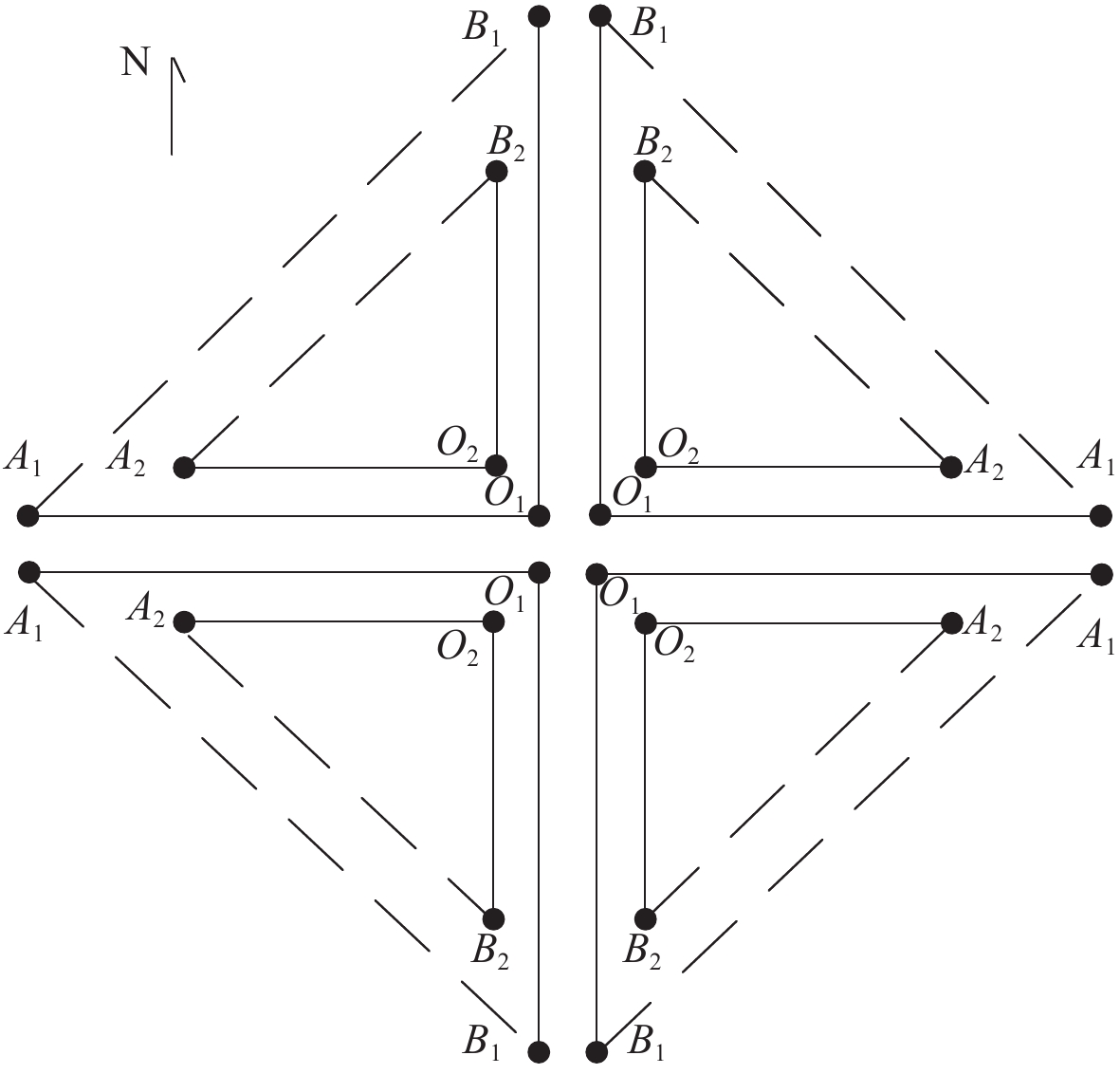
 下载:
下载:
